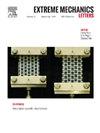Hard-to-soft part ratios in natural crawlers inform hybrid robotic design
IF 4.5
3区 工程技术
Q2 MATERIALS SCIENCE, MULTIDISCIPLINARY
引用次数: 0
Abstract
Most robots to date consist of either entirely hard parts or entirely soft parts. Nature, however, achieves a balance between hard and soft components, offering both adaptability and strength for adequate load-carrying capacity and locomotion in diverse environments. Inspired by nature, hybrid robotic designs, combining the flexibility of soft robots with the control and load-bearing capacity of hard robots, are being pursued. However, a proper range of the Hard-to-Soft Part Ratio (H2S-R) for the desirable performance of hybrid robots remains unclear. With a focus on crawlers, this study comprehensively compiles the H2S-R in crawling animals of four locomotion mechanisms: two-anchor, peristaltic, undulatory, and multi-legged crawling, and analyzes the trends and scaling in their performances. Results show distinct ranges of H2S-R in natural crawlers: 0.0005–0.003 for two-anchor crawlers, 0.08–0.09 for peristaltic, 0.02–0.08 for undulatory, and 1.0–2.4 for multi-legged. Within these ranges, except for the undulatory locomotion, increasing the H2S-R generally enhances their normalized crawling speed measured in body-lengths per second. Data for natural crawlers also show different ranges of normalized speeds as well as distinct scaling laws for different mechanisms. Comparisons with the performance of natural crawlers indicate that robotic crawlers have yet to achieve their full potential in crawling speed. This study provides guidelines for designing bio-inspired hybrid robots with potential applications in search and rescue, environmental monitoring, space exploration, and medical robotics.
自然履带的软硬零件比为混合动力机器人的设计提供了依据
迄今为止,大多数机器人要么完全由硬部件组成,要么完全由软部件组成。然而,大自然在硬构件和软构件之间取得了平衡,在不同的环境中提供了足够的承载能力和运动能力的适应性和强度。受大自然的启发,混合机器人的设计,将软机器人的灵活性与硬机器人的控制和承载能力相结合,正在被追求。然而,对于混合机器人理想性能的软硬零件比(H2S-R)的适当范围仍不清楚。本研究以爬行动物为研究对象,全面梳理了双锚爬行、蠕动爬行、波动爬行和多足爬行四种运动机制下爬行动物的H2S-R,并分析了其表现的趋势和尺度。结果表明,自然爬行动物的H2S-R含量范围明显不同:双锚爬行动物为0.0005-0.003,蠕动爬行动物为0.08-0.09,波动爬行动物为0.02-0.08,多足爬行动物为1.0-2.4。在这些范围内,除了波动运动外,增加H2S-R通常会提高它们的标准化爬行速度(以体长/秒为单位)。自然爬行器的数据也显示出不同的归一化速度范围以及不同机制的不同标度规律。与自然爬行器的性能比较表明,机器人爬行器尚未充分发挥其爬行速度的潜力。该研究为仿生混合机器人的设计提供了指导,这些机器人在搜救、环境监测、空间探索和医疗机器人等领域具有潜在的应用前景。
本文章由计算机程序翻译,如有差异,请以英文原文为准。
求助全文
约1分钟内获得全文
求助全文
来源期刊

Extreme Mechanics Letters
Engineering-Mechanics of Materials
CiteScore
9.20
自引率
4.30%
发文量
179
审稿时长
45 days
期刊介绍:
Extreme Mechanics Letters (EML) enables rapid communication of research that highlights the role of mechanics in multi-disciplinary areas across materials science, physics, chemistry, biology, medicine and engineering. Emphasis is on the impact, depth and originality of new concepts, methods and observations at the forefront of applied sciences.
 求助内容:
求助内容: 应助结果提醒方式:
应助结果提醒方式:


